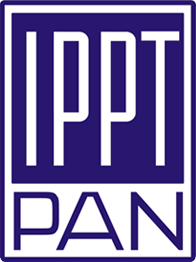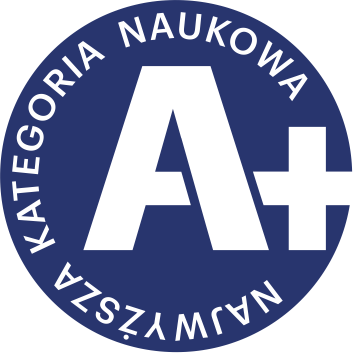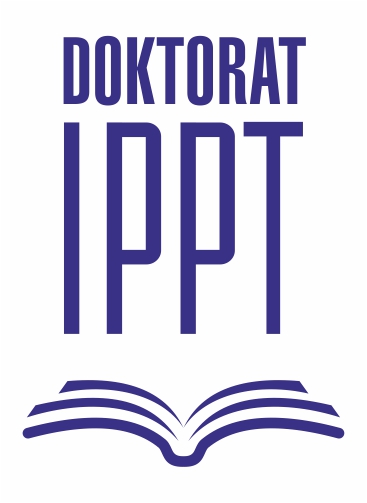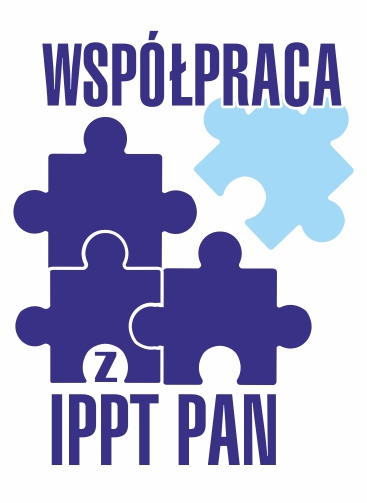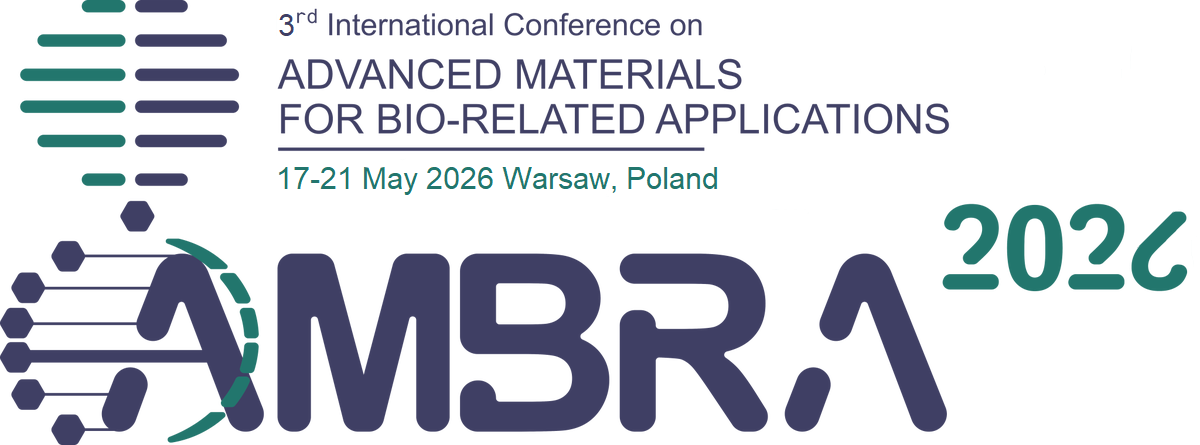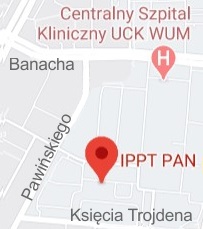| dr hab. inż. Zdzisław Nowak |

|
|
Doktorat
| 1988 | Zagadnienie lokalizacji deformacji lepkoplastycznych w tarczy kołowej wszechstronnie rozciąganej
|
| 1. | 2015-03-26 | Nowak Marcin | Analiza deformacji i zniszczenia struktur komórkowych w zastosowaniu do symulacji procesu infiltracji pianki korundowej ciekłym metalem |
Ostatnie publikacje
| 1. |
Manecka-Padaż A., Rożko E., Nowak Z., Chudziński P., Analytical Approach and Shooting Method Solution of Nonlocal Eringen Elasticity Problem of Nanorods,
ENGINEERING TRANSACTIONS (ROZPRAWY INŻYNIERSKIE), ISSN: 0867-888X, DOI: 10.24423/engtrans.2025.3681, pp.1-26, 2025 Streszczenie: Słowa kluczowe:
| 70p. | |||||||||||||||||||
| 2. |
Widłaszewski J., Nowak M.♦, Nowak Z., Kurp P.♦, Moment-curvature relation for laser-assisted bending of thin Inconel 718 beam,
JOURNAL OF THEORETICAL AND APPLIED MECHANICS, ISSN: 1429-2955, DOI: 10.15632/jtam-pl/202124 , Vol.63, No.3, pp.511-523, 2025 Streszczenie: Słowa kluczowe:
| 70p. | |||||||||||||||||||
| 3. |
Wilczewski S.♦, Nowak Z. M., Maj M., Osial M., Minikayev R.♦, Giersig M., Enhancing Epoxy Composites with Graphene and Graphene Oxide: Thermal and Mechanical Insights,
ChemNanoMat, ISSN: 2199-692X, DOI: 10.1002/cnma.202400488, pp.1-15, 2024 Streszczenie: Słowa kluczowe:
| 100p. | |||||||||||||||||||
| 4. |
Waldemar D.♦, Nowak Z. M., Ochrymiuk T.♦, Badur J.♦, TWO TOOLS FOR THE SCIENCE OF MATERIAL EFFORT– A REVIEW PAPER,
JOURNAL OF THEORETICAL AND APPLIED MECHANICS, ISSN: 1429-2955, DOI: 0.15632/jtam-pl/194319, Vol.62, No.4, pp.799-826, 2024 Streszczenie: Słowa kluczowe:
| 70p. | |||||||||||||||||||
| 5. |
Nowak Z., Kowalewski Z.L., Szymczak T.♦, Low velocity perforation of thick magnesium alloy AM60 plates impacted by rigid conical-nose impactor,
ARCHIVES OF CIVIL AND MECHANICAL ENGINEERING, ISSN: 1644-9665, DOI: 10.1007/s43452-022-00525-2, Vol.23, No.5, pp.1-20, 2022 Streszczenie: Słowa kluczowe:
| 140p. | |||||||||||||||||||
| 6. |
Widłaszewski J., Nowak Z., Kurp P.♦, Effect of pre-stress on laser-induced thermoplastic deformation of Inconel 718 beams,
Materials, ISSN: 1996-1944, DOI: 10.3390/ma14081847, Vol.14, No.8, pp.1847-1-18, 2021 Streszczenie: Słowa kluczowe:
| 140p. | |||||||||||||||||||
| 7. |
Postek E., Nowak Z., Pęcherski R.B., Viscoplastic flow of functional cellular materials with use of peridynamics,
MECCANICA, ISSN: 0025-6455, DOI: 10.1007/s11012-021-01383-7, pp.1-18, 2021 Streszczenie: Słowa kluczowe:
| 100p. | |||||||||||||||||||
| 8. |
Pęcherski R.B., Rusinek A., Frąś T., Nowak M., Nowak Z., Energy-based yield condition for orthotropic materials exhibiting asymmetry of elastic range,
ARCHIVES OF METALLURGY AND MATERIALS, ISSN: 1733-3490, DOI: 10.24425/amm.2020.132819, Vol.65, No.2, pp.771-778, 2020 Streszczenie: Słowa kluczowe:
| 40p. | |||||||||||||||||||
| 9. |
Postek E., Pęcherski R.B., Nowak Z., Peridynamic simulation of crushing processes in copper open-cell foam,
ARCHIVES OF METALLURGY AND MATERIALS, ISSN: 1733-3490, DOI: 10.24425/amm.2019.130133, Vol.64, No.4, pp.1603-1610, 2019 Streszczenie: Słowa kluczowe:
| 40p. | |||||||||||||||||||
| 10. |
Nowak Z., Nowak M., Pęcherski R.B., Wiśniewski K., Widłaszewski J., Kurp P.♦, Computational modeling of thermoplastic behavior of inconel 718 in application to laser-assisted bending of thin-walled tubes,
INTERNATIONAL JOURNAL FOR MULTISCALE COMPUTATIONAL ENGINEERING, ISSN: 1543-1649, DOI: 10.1615/IntJMultCompEng.2019029858, Vol.17, No.3, pp.317-338, 2019 Streszczenie: Słowa kluczowe:
| 40p. | |||||||||||||||||||
| 11. |
Widłaszewski J., Nowak M., Nowak Z., Kurp P.♦, Laser-assisted thermomechanical bending of tube profiles,
ARCHIVES OF METALLURGY AND MATERIALS, ISSN: 1733-3490, DOI: 10.24425/amm.2019.126268, Vol.64, No.1, pp.421-430, 2019 Streszczenie: Słowa kluczowe:
| 40p. | |||||||||||||||||||
| 12. |
Nowak M., Nowak Z., Pęcherski R.B., Potoczek M.♦, Śliwa R.E.♦, ASSESSMENT OF FAILURE STRENGTH OF REAL ALUMINA FOAMS WITH USE OF THE PERIODIC STRUCTURE MODEL,
ARCHIVES OF METALLURGY AND MATERIALS, ISSN: 1733-3490, DOI: 10.24425/amm.2018.125122, Vol.63, No.4, pp.1901-1906, 2018 Streszczenie: Słowa kluczowe:
| 30p. | |||||||||||||||||||
| 13. |
Zajączkowska U.♦, Kucharski S., Nowak Z., Grabowska K.♦, Morphometric and mechanical characteristics of Equisetum hyemale stem enhance its vibration,
PLANTA, ISSN: 0032-0935, DOI: 10.1007/s00425-017-2648-1, Vol.245, No.4, pp.835-848, 2017 Streszczenie: Słowa kluczowe:
| 40p. | |||||||||||||||||||
| 14. |
Poniżnik Z., Nowak Z., Basista M., Numerical modeling of deformation and fracture of reinforcing fibers in ceramic-metal composites,
INTERNATIONAL JOURNAL OF DAMAGE MECHANICS, ISSN: 1056-7895, DOI: 10.1177/1056789515611945, Vol.26, No.5, pp.711-734, 2017 Streszczenie: Słowa kluczowe:
| 35p. | |||||||||||||||||||
| 15. |
Basista M., Węglewski W., Bochenek K., Poniżnik Z., Nowak Z., Micro-CT Finite Element Analysis of Thermal Residual Stresses and Fracture in Metal-Ceramic Composites,
Advanced Engineering Materials, ISSN: 1438-1656, DOI: 10.1002/adem.201600725, Vol.19, No.8, pp.1600725-1-9, 2017 Streszczenie:
| 30p. | |||||||||||||||||||
| 16. |
Pęcherski R.B., Nowak M., Nowak Z., Virtual metallic foams. Application for dynamic crushing analysis,
INTERNATIONAL JOURNAL FOR MULTISCALE COMPUTATIONAL ENGINEERING, ISSN: 1543-1649, DOI: 10.1615/IntJMultCompEng.2017020306, Vol.15, No.5, pp.431-442, 2017 Streszczenie: Słowa kluczowe:
| 25p. | |||||||||||||||||||
| 17. |
Nowak Z., Nowak M., Pęcherski R.B., Potoczek M.♦, Śliwa R.E.♦, Numerical simulations of mechanical properties of alumina foams based on computed tomography,
JOURNAL OF MECHANICS OF MATERIALS AND STRUCTURES, ISSN: 1559-3959, DOI: 10.2140/jomms.2017.12.107, Vol.12, No.1, pp.107-121, 2017 Streszczenie: Słowa kluczowe:
| 20p. | |||||||||||||||||||
| 18. |
Widłaszewski J., Nowak M., Nowak Z., Kurp P.♦, Laser-assisted forming of thin-walled profiles,
Metal Forming, ISSN: 0867-2628, Vol.XXVIII, No.3, pp.183-198, 2017 Streszczenie: Słowa kluczowe:
| 10p. | |||||||||||||||||||
| 19. |
Nowak Z., Nowak M., Pęcherski R.B., Potoczek M.♦, Śliwa R.E.♦, Mechanical properties of the ceramic open-cell foams of variable cell sizes,
ARCHIVES OF METALLURGY AND MATERIALS, ISSN: 1733-3490, DOI: 10.1515/amm-2015-0333, Vol.60, No.3, pp.1957-1963, 2015 Streszczenie: Słowa kluczowe:
| 30p. | |||||||||||||||||||
| 20. |
Nowak Z., Perzyna P., The Identfication Procedure for The Constitutive Model of Elasto-Viscoplasticity Describing the Behaviour of Nanocrystalline Titanium,
ENGINEERING TRANSACTIONS (ROZPRAWY INŻYNIERSKIE), ISSN: 0867-888X, Vol.62, No.3, pp.221-240, 2014 Streszczenie: Słowa kluczowe:
| 7p. | |||||||||||||||||||
| 21. |
Nowak M., Nowak Z., Pęcherski R.B., Potoczek M.♦, Śliwa R.E.♦, On the reconstruction method of ceramic foam structures and the methodology of Young modulus determination,
ARCHIVES OF METALLURGY AND MATERIALS, ISSN: 1733-3490, DOI: 10.2478/amm-2013-0154, Vol.58, No.4, pp.1219-1222, 2013 Streszczenie: Słowa kluczowe:
| 20p. | |||||||||||||||||||
| 22. |
Frąś T., Nowak Z., Perzyna P., Pęcherski R.B., Identification of the model describing viscoplastic behaviour of high strength metals,
INVERSE PROBLEMS IN SCIENCE AND ENGINEERING, ISSN: 1741-5977, DOI: 10.1080/17415977.2010.531474, Vol.19, No.1, pp.17-30, 2011 Streszczenie: Słowa kluczowe:
| 20p. | |||||||||||||||||||
| 23. |
Potoczek M.♦, Śliwa R.E.♦, Pęcherski R.B., Nowak Z., Nowak M., Modelowanie struktury geometrycznej i wytrzymałości na ściskanie pianek ceramicznych przeznaczonych do infiltracji ciekłymi metalami,
RUDY I METALE NIEŻELAZNE, ISSN: 0035-9696, Vol.R56, No.11, pp.594-598, 2011 Streszczenie: Słowa kluczowe:
| 7p. | |||||||||||||||||||
| 24. |
Nowacki W.K., Nowak Z., Perzyna P., Pęcherski R.B., Effect of strain rate on ductile fracture. A new methodology,
JOURNAL OF THEORETICAL AND APPLIED MECHANICS, ISSN: 1429-2955, Vol.48, No.4, pp.1003-1026, 2010 Streszczenie: Słowa kluczowe:
| 9p. | |||||||||||||||||||
| 25. |
Nowak Z., Constitutive modelling and parameter identification for rubber-like materials,
ENGINEERING TRANSACTIONS (ROZPRAWY INŻYNIERSKIE), ISSN: 0867-888X, Vol.LVI, No.2, pp.117-157, 2008 Streszczenie: Słowa kluczowe:
| ||||||||||||||||||||
| 26. |
Nowak Z., Perzyna P., Pęcherski R.B., Description of viscoplastic flow accounting for shear banding,
ARCHIVES OF METALLURGY AND MATERIALS, ISSN: 1733-3490, Vol.52, No.2, pp.217-222, 2007 Streszczenie: Słowa kluczowe:
| ||||||||||||||||||||
| 27. |
Pieczyska E.A., Pęcherski R.B., Gadaj S.P., Nowacki W.K., Nowak Z., Matyjewski M.♦, Experimental and theoretical investigations of glass fibre reinforced composite subjected to uniaxial compression for a wide spectrum of strain rates,
ARCHIVES OF MECHANICS, ISSN: 0373-2029, Vol.58, No.3, pp.273-291, 2006 Streszczenie: Słowa kluczowe:
| ||||||||||||||||||||
| 28. |
Nowak Z., Stachurski A.♦, Robust identification of an augmented Gurson model for elasto-plastic porous media,
ARCHIVES OF MECHANICS, ISSN: 0373-2029, Vol.58, No.1, pp.125-154, 2006 Streszczenie: Słowa kluczowe:
| ||||||||||||||||||||
| 29. |
Pęcherski R.B., Nalepka K.T., Nowak Z., Próba modelowania mechanicznych własności nanometali,
INŻYNIERIA MATERIAŁOWA, ISSN: 0208-6247, Vol.4, pp.170-174, 2005 Streszczenie: Słowa kluczowe:
| ||||||||||||||||||||
| 30. | Perzyna P., Nowak Z., Determination of material functions in a model of dynamic fragmentation processes, ZAMM-ZEITSCHRIFT FUR ANGEWANDTE MATHEMATIK UND MECHANIK, ISSN: 0044-2267, Vol.71, No.4, pp.378-382, 1991 | ||||||||||||||||||||
| 31. | Nowak Z., Stachurski A.♦, Global Optimization Approach to Material Functions Identification in Plastic Flow of Voided Media, Prace IPPT - IFTR Reports, ISSN: 2299-3657, No.47, pp.1-36, 1989 | ||||||||||||||||||||
| 32. | Perzyna P., Nowak Z., Równanie ewolucji pustek w obszarze szyjki, Prace IPPT - IFTR Reports, ISSN: 2299-3657, No.24, pp.1-23, 1985 | ||||||||||||||||||||
| 33. | Nowak Z., Obliczenia oporu profilów lotniczych, Prace IPPT - IFTR Reports, ISSN: 2299-3657, No.35, pp.1-38, 1974 |
Lista ostatnich monografii
|
1. |
Nowak Z., Metoda identyfikacji w mechanice materiałów ciągliwych z uszkodzeniami, Rozprawa habilitacyjna, IPPT Reports on Fundamental Technological Research, 5, pp.1-213, 2006 |
Lista rozdziałów w ostatnich monografiach
|
1. |
Perzyna P., Nowak Z., Mathematical methods in continuum mechanics, rozdział: The identification procedure for the constitutive model of elasto-viscoplasticity describing the behaviour of nanocrystalline iron during quasistatic and dynamic loading processes, Technical University of Łódź, K. Wilmański, B. Michalak, J. Jędrysiak (Eds.), pp.63-88, 2011 | |
|
2. |
Pęcherski R.B., Nowacki W.K., Nowak Z., Perzyna P., Workshop in Memory of Prof. J.R. Klepaczko: Dynamic Behaviour of Materials, rozdział: Effect of strain rate on ductile fracture. A new methodology, LPMM, Metz, Rusinek A., Chevrier P. (Eds.), pp.65-73, 2009 |
Prace konferencyjne
| 1. |
Libura T., Sienkiewicz J.♦, Nowak Z., Kowalewski Z., Rusinek A., Voyiadjis G.Z.♦, Gunputh U.♦, Wood P.♦, The influence of build parameters on the collapse behaviour of a highly porous random open-cell lattice 3D printed in IN718 alloy,
DynaMAT'2024, The 14 international conference of DYNAMIC BEHAVIOUR OF MATERIALS AND ITS APPLICATIONS IN INDUSTRIAL PROCESSES, 2024-10-16/10-18, La Marsa (TN), pp.1-2, 2024 Streszczenie: Słowa kluczowe:
| |||||||||||||||||||||||||
| 2. |
Widłaszewski J., Nowak M., Nowak Z., Kurp P.♦, Curvature Change in Laser-Assisted Bending of Inconel 718,
Physical Science Forum, ISSN: 2673-9984, DOI: 10.3390/psf2022004026, Vol.4, No.1, pp.26-1-8, 2022 Streszczenie: Słowa kluczowe:
| |||||||||||||||||||||||||
| 3. |
Nowak Z., Nowak M., Widłaszewski J., Kurp P.♦, Experimental and Numerical Investigation on Laser-Assisted Bending of Pre-Loaded Metal Plate,
CMM 2017, 22nd International Conference on Computer Methods in Mechanics, 2017-09-13/09-16, Lublin (PL), DOI: 10.1063/1.5019148, Vol.1922, pp.140006-1-7, 2018 Streszczenie: Słowa kluczowe:
| 20p. | ||||||||||||||||||||||||
| 4. |
Pęcherski R.B., Nowak Z., Postek E., The concept of virtual cellular material in peridynamic modelling of deformation processes,
ICPS5, 5th International Conference on Protective Structures, 2018-08-19/08-23, Poznań (PL), pp.718-721, 2018 Streszczenie: Słowa kluczowe:
| |||||||||||||||||||||||||
| 5. |
Nowak Z., Nowak M., Pęcherski R.B., Application of the shock wave theory for the assessment of crushing force in the open-cell copper foams,
ICPS5, 5th International Conference on Protective Structures, 2018-08-19/08-23, Poznań (PL), pp.714-717, 2018 Streszczenie: Słowa kluczowe:
| |||||||||||||||||||||||||
| 6. |
Kowalewski Z.L., Nowak Z., Pęcherski R.B., Dynamic testing of materials using shpb and dict on typical and miniaturized specimens – numerical modelling and experiment,
PSH, 7th International Conference on Protection of Structures against Hazards, 2018-10-30/10-31, Hanoi (VN), pp.174-183, 2018 Streszczenie: Słowa kluczowe:
| |||||||||||||||||||||||||
| 7. | Pęcherski R.B., Kowalczyk-Gajewska K., Nowak Z., Opis udziału pasm ścinania w płynięciu plastycznym polikrystalicznych metali z uwzględnieniem wpływu zmiany drogi odkształcenia, Niejednorodności odkształcenia w procesach przeróbki plastycznej i rekrystalizacji, Seminarium poświęcone 70. rocznicy urodzin Profesora Z. Jasieńskiego, 2005-01-21/01-21, Kraków (PL), pp.191-202, 2005 |
Abstrakty konferencyjne
| 1. | Nowak Z., Giersig M., The indentation test method for predicting stress–strain relationships of materials based on energy density equivalence, 13th Wdzydzeanum Conference on Fluid–Solid Interaction, 2025-08-31/09-04, Wdzydze Kiszewskie (PL), pp.21-21, 2025 | |||||||||||||||||||||||||
| 2. |
Libura T., Sienkiewicz J.♦, Nowak Z., Kowalewski Z. L., Rusinek A.♦, Voyiadjis G.♦, Gunputh U.♦, Wood P.♦, THE INFLUENCE OF BUILD PARAMETERS ON THE COLLAPSE BEHAVIOUR OF A HIGHLY POROUS RANDOM OPEN-CELL LATTICE 3D PRINTED IN IN718 ALLOY,
41DAS, 41st Danubia-Adria Symposium on Advances in Experimental Mechanics, 2025-09-23/09-26, Kragujevac (XS), Vol.Proceedings of 41st Danubia-Adria Symposium Advances in Experimental Mechanics, pp.3-4, 2025 Streszczenie: Słowa kluczowe:
| |||||||||||||||||||||||||
| 3. | Widłaszewski J., Nowak M., Nowak Z., Kurp P.♦, MOMENT-CURVATURE RELATION FOR LASER-ASSISTED BENDING OF THIN INCONEL 718 BEAM, DAS 2024, 40th DANUBIA-ADRIA SYMPOSIUM on Advances in Experimental Mechanics, 2024-09-24/09-27, Gdańsk (PL), pp.169-170, 2024 | |||||||||||||||||||||||||
| 4. | Pokorska I., Nowak Z., Poński M., Wilczewski S., Grzywacz H., Giersig M., NANO-INDENTATION RESPONSE OF GRAPHENE REINFORCED CEMENT MORTAR COMPOSITES, DAS 2024, 40th DANUBIA-ADRIA SYMPOSIUM on Advances in Experimental Mechanics, 2024-09-24/09-27, Gdańsk (PL), pp.1-2, 2024 | |||||||||||||||||||||||||
| 5. | Libura T., Sienkiewicz J.♦, Nowak Z., Kowalewski Z.L., Rusinek A., Voyiadjis G.Z.♦, Gunputh U.♦, Wood P.♦, CHARACTERISATION OF THE COLLAPSE BEHAVIOUR IN 3D PRINTED IN718 ALLOY UNDER A RANGE OF STRESS STATES AND STRAIN RATES, DAS 2024, 40th DANUBIA-ADRIA SYMPOSIUM on Advances in Experimental Mechanics, 2024-09-24/09-27, Gdańsk (PL), pp.1-2, 2024 | |||||||||||||||||||||||||
| 6. | Nowak Z., Giersig M., Micro indentation mechanical properties of graphene nanoenhanced cement paste assessed by energy-based method, 12th Wdzydzeanum Conference on Fluid–Solid Interaction, 2024-09-01/09-05, Wdzydze Kiszewskie (PL), pp.17, 2024 | |||||||||||||||||||||||||
| 7. | Nowak Z., Wilczewski S., Osial M., Giersig M., Mechanical Behaviour and Numerical Modelling of Epoxy Matrix Composite Doped with Carbon Nanoparticles, SolMech 2024, 43rd Solid Mechanics Conference, 2024-09-16/09-18, Wrocław (PL), pp.21, 2024 | |||||||||||||||||||||||||
| 8. | Pokorska-Służalec I., Nowak Z., Grzywacz H., Wilczewski S., Giersig M., Characterizations of Graphene Reinforced Cement Matrix Composites using Nanoindentation, SolMech 2024, 43rd Solid Mechanics Conference, 2024-09-16/09-18, Wrocław (PL), pp.22, 2024 | |||||||||||||||||||||||||
| 9. | Manecka-Padaż A., Nowak Z., Experimental investigation of Euler’s elastica: in-situ SEM nanowire post-buckling, SolMech 2024, 43rd Solid Mechanics Conference, 2024-09-16/09-18, Wrocław (PL), pp.24, 2024 | |||||||||||||||||||||||||
| 10. | Nowak Z., Giersig M., The epoxy resin nanocomposite: Effect of micro-shear bands on mechanical behaviour, WWFSI, 11th Wdzydzeanum Conference on Fluid-Solid Interaction, 2023-09-03/09-07, Wdzydze Kiszewskie (PL), pp.19-19, 2023 | |||||||||||||||||||||||||
| 11. | Manecka-Padaż A., Nowak Z., Experimental investigation of Euler’s elastica: in-situ SEM nanowire post-buckling, WWFSI, 11th Wdzydzeanum Conference on Fluid-Solid Interaction, 2023-01-03/01-07, Wdzydze Kiszewskie (PL), pp.14-14, 2023 | |||||||||||||||||||||||||
| 12. | Nowak Z., Giersig M., Zastosowanie teorii lepkoplastycznego płynięcia ciał stałych wywołane pasmami ścinania do opisu nanopolimerów, XIII Konferencja Naukowa PLASTMET 2023, 2023-11-07/11-10, Łańcut (PL), pp.119-120, 2023 | |||||||||||||||||||||||||
| 13. | Pęcherski R.B., Nowak Z., SHEAR BANDING - A KEY MECHANISM CONTROLLING VISCOPLASTIC FLOW. I. DEVELOPMENT OF CONSTITUTIVE RELATIONS, ICEM, 19th International Conference on Experimental Mechanics, 2022-07-17/07-21, Kraków (PL), No.1, pp.212-212, 2022 | |||||||||||||||||||||||||
| 14. |
Nowak Z., Pęcherski R.B., SHEAR BANDING - A KEY MECHANISM CONTROLLING VISCOPLASTIC FLOW. II. NUMERICAL SIMULATIONS OF SOME EXPERIMENTALLY PERFORMED PROCESSES,
ICEM, 19th International Conference on Experimental Mechanics, 2022-07-17/07-21, Kraków (PL), No.1, pp.213-214, 2022 Streszczenie:
| |||||||||||||||||||||||||
| 15. | Wood P.♦, Gunputh U.♦, Williams G.♦, Carter W.♦, Boud F.♦, Bahi S.♦, Rusinek A., Kowalewski Z.L., Nowak Z., Libura T., Vojiadjis G.Z.♦, Diaz-Alvare J.♦, Miguelez M.H.♦, SELECTIVE LASER MELTING OF A HIGH PRECISION TURBOMACHINERY APPLICATION IN IN718 ALLOY, ICEM, 19th International Conference on Experimental Mechanics, 2022-07-17/07-21, Kraków (PL), pp.34-35, 2022 | |||||||||||||||||||||||||
| 16. | Pęcherski R., Nowak Z., DEVELOPMENT OF CONSTITUTIVE RELATIONS OF VISCOPLASTICITY ACCOUNTING FOR SHEAR BANDING, CMM-SolMech 2022, 24th International Conference on Computer Methods in Mechanics; 42nd Solid Mechanics Conference, 2022-09-05/09-08, Świnoujście (PL), No.282, pp.1-1, 2022 | |||||||||||||||||||||||||
| 17. | Wilczewski S., Nowak Z., Pęcherski R., Giersig M., A NEW CONCEPT OF EPOXY RESIN COMPOSITE DOPED WITH CARBON-BASED NANOPARTICLES: MANUFACTURING, EXPERIMENT AND MODELING, CMM-SolMech 2022, 24th International Conference on Computer Methods in Mechanics; 42nd Solid Mechanics Conference, 2022-09-05/09-08, Świnoujście (PL), No.185, pp.1-1, 2022 | |||||||||||||||||||||||||
| 18. | Widłaszewski J., Nowak M., Nowak Z., Kurp P.♦, Curvature Change in Laser-Assisted Bending of Inconel 718, ICEM, 19th International Conference on Experimental Mechanics, 2022-07-17/07-21, Kraków (PL), pp.68-69, 2022 | |||||||||||||||||||||||||
| 19. | Nowak Z., Pęcherski R.B., On constitutive behavior and shear bands in nanocrystalline iron, 9th Wdzydzenaum Workshop on FLUID – SOLID INTERACTION, 2021-09-05/09-10, Wdzydze Kiszewskie (PL), pp.21, 2021 | |||||||||||||||||||||||||
| 20. | Nowak Z., Giersig M., Pęcherski R.B., Badania doświadczalne deformowanych quasi-statycznie żywic epoksydowych, PLASTMET 2021, XII Konferencja Naukowa, Zintegrowane Studia Podstaw Deformacji Plastycznej Metali, 2021-11-23/11-26, Łańcut (PL), No.1, pp.132-133, 2021 | |||||||||||||||||||||||||
| 21. |
Postek E., Nowak Z., Pęcherski R., Viscoplastic material with shear bands effect,
USNCCM16, 16th U.S. National Congress on Computational Mechanics, 2021-07-25/07-29, Chicago (US), pp.1, 2021 Streszczenie: Słowa kluczowe:
| |||||||||||||||||||||||||
| 22. | Nowak Z., Pęcherski R.B., Constitutive modelling of shear bands effect in ductile materials: formulation and computational aspects, 8th Wdzydzeanum Workshop on „FLUID – SOLID INTERACTION”, 2020-08-30/09-03, Wdzydze Kiszewskie (PL), pp.1-2, 2020 | |||||||||||||||||||||||||
| 23. | Pęcherski R.B., Rusinek A., Frąś T.♦, Nowak M., Nowak Z., Energetyczny warunek plastyczności materiałów ortotropowych wykazujących asymetrię zakresu sprężystego, OMIS 2019, XIII Konferencja Naukowa Odkształcalność Metali i Stopów, 2019-11-19/11-22, Łańcut (PL), pp.48-49, 2019 | |||||||||||||||||||||||||
| 24. | Nowak Z., Nowak M., Pęcherski R.B., On the energy absorbtion in open cell foams under dynamic loading, DynaMAT, The 13th WORKSHOP on DYNAMIC BEHAVIOR OF MATERIALS AND ITS APPLICATIONS IN INDUSTRIAL PROCESSES, 2019-04-17/04-19, Nicosia (CY), pp.1-2, 2019 | |||||||||||||||||||||||||
| 25. | Nowak Z., Numerical simulation of crushing processes in metallic open-cell foam, PCM-CMM, 4th Polish Congress of Mechanics, 23rd International Conference on Computer Methods in Mechanics, 2019-09-08/09-12, Kraków (PL), pp.1, 2019 | |||||||||||||||||||||||||
| 26. | Kowalewski Z.L., Nowak Z., Pęcherski R.B., Libura T., Identification of effects associated to dynamic testing using shpb or dict- experiment and numerical analysis, DynaMAT, The 13th WORKSHOP on DYNAMIC BEHAVIOR OF MATERIALS AND ITS APPLICATIONS IN INDUSTRIAL PROCESSES, 2019-04-17/04-19, Nicosia (CY), pp.1-2, 2019 | |||||||||||||||||||||||||
| 27. |
Postek E., Pęcherski R.B., Nowak Z., Viscoplasticity effect during impact of metallic foams,
CCAM & 3D-Printing, Collaborative Conference on Advanced Materials, 2019-08-26/08-30, St. Julian's (MT), pp.16-17, 2019 Streszczenie: Słowa kluczowe:
| |||||||||||||||||||||||||
| 28. |
Postek E., Pęcherski R.B., Nowak Z., Perydynamiczna symulacja procesów zgniatania otwartokomórkowych pianek miedzianych,
PLASTMET, 11 KONFERENCJA ZINTEGROWANE STUDIA PODSTAW DEFORMACJI PLASTYCZNEJ METALI, 2018-11-27/11-30, Łańcut (PL), pp.120-121, 2018 Streszczenie: Słowa kluczowe:
| |||||||||||||||||||||||||
| 29. | Nowak Z., Nowak M., Pęcherski R.B., Propagation of compaction waves in the open-cell copper foams, ESMC, 10th European Solid Mechanics Conference, 2018-07-02/07-06, Bologna (IT), pp.1, 2018 | |||||||||||||||||||||||||
| 30. | Nowak Z., Nowak M., Widłaszewski J., Kurp P.♦, Symulacje numeryczne laserowo wspomaganego gięcia materiałów wykorzystywanych w przemyśle lotniczym, PLASTMET, 11 KONFERENCJA ZINTEGROWANE STUDIA PODSTAW DEFORMACJI PLASTYCZNEJ METALI, 2018-11-27/11-30, Łańcut (PL), pp.97-98, 2018 | |||||||||||||||||||||||||
| 31. | Widłaszewski J., Nowak M., Nowak Z., Kurp P.♦, Termomechaniczne kształtowanie profili rurowych wspomagane laserowo, PLASTMET, 11 KONFERENCJA ZINTEGROWANE STUDIA PODSTAW DEFORMACJI PLASTYCZNEJ METALI, 2018-11-27/11-30, Łańcut (PL), pp.162-163, 2018 | |||||||||||||||||||||||||
| 32. | Nowak Z., Nowak M., Pęcherski R.B., Wiśniewski K., Widłaszewski J., Kurp P.♦, Computational Modelling of Thermoplastic Behaviour of Inconel 718 in Application to Laser-Assisted Bending of Thin-Walled Alloy Tubes, WCCM2018, 13th World Congress on Computational Mechanics, 2018-07-22/07-27, Nowy Jork (US), pp.1, 2018 | |||||||||||||||||||||||||
| 33. | Nowak Z., Nowak M., Widłaszewski J., Kurp P.♦, Experimental and numerical investigation on laser-assisted bending of pre-loaded inconel 718 beams, SolMech 2018, 41st SOLID MECHANICS CONFERENCE, 2018-08-27/08-31, Warszawa (PL), pp.282-283, 2018 | |||||||||||||||||||||||||
| 34. | Libura T., Nowak Z., Kowalewski Z.L., Widłaszewski J., Behaviour of inconel 718 aerospace alloy thin sheets under in-plane tension-compression, SME, XXVIII Symposium On Experimental Mechanics of Solids in memory of prof. Jacek Stupnicki, 2018-10-17/10-20, Jachranka (PL), pp.42-42, 2018 | |||||||||||||||||||||||||
| 35. | Pawłowski P., Pęcherski R.B., Nowak M., Nowak Z., Skłodowski M.♦, Application of the Concept of Virtual Material for the Design of Additive Manufacturing Processes of Open Cell Foams, WCCM 2018, 13th World Congress on Computational Mechanics, 2018-07-22/07-27, Nowy Jork (US), pp.584-584, 2018 | |||||||||||||||||||||||||
| 36. |
Postek E., Nowak Z., Pęcherski R.B., Impact resistance of crushable foam skeleton,
SolMech 2018, 41st SOLID MECHANICS CONFERENCE, 2018-08-27/08-31, Warszawa (PL), pp.1-2, 2018 Streszczenie: Słowa kluczowe:
| |||||||||||||||||||||||||
| 37. |
Nowak Z., Pęcherski R.B., Maj P.♦, Niestabilność plastycznego płynięcia w stopie Inconel 718. Badania doświadczalne Serrated flow in Inconel 718 alloy. Experimental investigations,
OMIS'2017, XII Konferencja NAukowa ODKSZTAŁCALNOŚĆ METALI I STOPÓW, 2017-11-21/11-24, Łańcut (PL), pp.47-48, 2017 Streszczenie: Słowa kluczowe:
| |||||||||||||||||||||||||
| 38. |
Nowak Z., Nowak M., Pęcherski R.B., Dynamic compression strength of copper open-cell foams,
DBM, 11th Workshop Dynamic Behaviour of Materials and its Applications in Industrial Processes, 2017-08-23/08-25, Guimarães (PT), pp.8-9, 2017 Streszczenie: Słowa kluczowe:
| |||||||||||||||||||||||||
| 39. |
Pęcherski R.B., Nowak Z., Application of virtual cellular material concept for the simulations of dynamic loading processes,
MatCel'2017 & DynMatCel'2017, Cellular Materials: Structural Behaviour, Modelling and Characterisation, 2017-09-25/09-27, Aveiro (PT), pp.54-54, 2017 Streszczenie: Słowa kluczowe:
| |||||||||||||||||||||||||
| 40. |
Pęcherski R.B., Nowak Z., Nowak M., Natonik K.J.♦, Potoczek M.♦, Śliwa R.E.♦, Problems of virtual cellular materials: representative volume element and energy-based assessment of failure strength,
DBM, 11th Workshop Dynamic Behaviour of Materials and its Applications in Industrial Processes, 2017-08-23/08-25, Guimarães (PT), pp.12-13, 2017 Streszczenie: Słowa kluczowe:
| |||||||||||||||||||||||||
| 41. |
Nowak Z., Nowak M., Widłaszewski J., Kurp P.♦, Experimental and numerical investigation on laser-assisted bending of pre-loaded metal plate,
CMM 2017, 22nd International Conference on Computer Methods in Mechanics, 2017-09-13/09-16, Lublin (PL), pp.MS13-37-38, 2017 Streszczenie: Słowa kluczowe:
| |||||||||||||||||||||||||
| 42. |
Kowalewski Z.L., Nowak Z., Pęcherski R.B., Investigations of Tantalum at Direct Impact Compression Tests on Miniaturized Specimens,
PLASTICITY 2017, INTERNATIONAL CONFERENCE ON PLASTICITY, DAMAGE, AND FRACTURE 2017, 2017-01-03/01-09, Puerto Vallarta (MX), pp.100-102, 2017 Streszczenie:
| |||||||||||||||||||||||||
| 43. |
Nowak Z., Kowalewski Z.L., Pęcherski R.B., A numerical solution of longitudinal wave propagation in a miniaturized specimens of tantalum at direct impact compression test,
DYMAT, 10th Workshop, 2016-08-24/08-26, Poznań (PL), pp.69-71, 2016 Streszczenie: Słowa kluczowe:
| |||||||||||||||||||||||||
| 44. |
Poniżnik Z., Nowak Z., Basista M., Numerical modeling of fracture toughness of metal-ceramic interpenetrating phase composites with account of material microstructure,
SolMech 2016, 40th Solid Mechanics Conference, 2016-08-29/09-02, Warszawa (PL), No.P198, pp.1-2, 2016 Streszczenie: Słowa kluczowe:
| |||||||||||||||||||||||||
| 45. |
Poniżnik Z., Nowak Z., Basista M., Numerical modeling of crack growth in interpenetrating metal-ceramic composites,
ICDM2, 2nd International Conference on Damage Mechanics, 2015-07-08/07-11, Troyes (FR), pp.41, 2015 Streszczenie: Słowa kluczowe:
| |||||||||||||||||||||||||
| 46. |
Nowak Z., Nowak M., Pęcherski R.B., Numeryczna analiza dynamicznych procesów ściskania metalicznych pianek otwartokomórkowych,
OMIS'2015, XI Konferencja Odkształcalność Metali i Stopów, 2015-11-17/11-20, Łańcut (PL), pp.59-60, 2015 Streszczenie: Słowa kluczowe:
| |||||||||||||||||||||||||
| 47. |
Nowak M., Pęcherski R.B., Nowak Z., Frąś L.J., Numeryczna rekonstrukcja struktury pianek otwartokomórkowych z wykorzystaniem tomografii komuterowej,
OMIS'2015, XI Konferencja Odkształcalność Metali i Stopów, 2015-11-17/11-20, Łańcut (PL), pp.61-62, 2015 Streszczenie: Słowa kluczowe:
| |||||||||||||||||||||||||
| 48. |
Nowak Z., Nowak M., Pęcherski R.B., Numerical simulation of the dynamic processes in metal foams. Part II. Compression tests of open cell copper foams,
PETER 2015, Annual International Workshop on Dynamic Behaviour of Structures and Materials, Interaction and Friction Across the Strain Rates, 2015-08-26/08-28, London (GB), Vol.1, pp.21-22, 2015 Streszczenie: Słowa kluczowe:
| |||||||||||||||||||||||||
| 49. |
Pęcherski R.B., Nowak M., Nowak Z., Numerical simulation of dynamic processes in metal foams. I. virtual metallic foam,
PETER 2015, Annual International Workshop on Dynamic Behaviour of Structures and Materials, Interaction and Friction Across the Strain Rates, 2015-08-26/08-28, London (GB), Vol.1, pp.19-20, 2015 Streszczenie: Słowa kluczowe:
| |||||||||||||||||||||||||
| 50. |
Nowak Z., Nowak M., Pęcherski R.B., Potoczek M.♦, Śliwa R.E.♦, Numerical simulations of mechanical properties of alumina foams based on computer tomography,
PCM-CMM 2015, 3rd Polish Congress of Mechanics and 21st Computer Methods in Mechanics, 2015-09-08/09-11, Gdańsk (PL), pp.853-854, 2015 Streszczenie: Słowa kluczowe:
| |||||||||||||||||||||||||
| 51. |
Nowak M., Nowak Z., Pęcherski R.B., Energy-based multisurface limit criteria in application for modelling and simulation of metal forming processes,
8th Workshop on Dynamic Behaviour of Materials and Its Applications in Industrial Processes, 2014-06-25/06-27, Warszawa (PL), pp.53-54, 2014 Streszczenie: Słowa kluczowe:
| |||||||||||||||||||||||||
| 52. |
Nowak Z., Nowak M., Pęcherski R.B., Numerical simulation of metal forming processes with application of modified elastic-plastic model,
8th Workshop on Dynamic Behaviour of Materials and Its Applications in Industrial Processes, 2014-06-25/06-27, Warszawa (PL), pp.51-52, 2014 Streszczenie: Słowa kluczowe:
| |||||||||||||||||||||||||
| 53. |
Nowak Z., Nowak M., Pęcherski R.B., Potoczek M.♦, Śliwa R.E.♦, Własności mechaniczne pianek ceramicznych o komórkach otwartych i różnej porowatości,
IX Seminarium Naukowe ZINTEGROWANE STUDIA PODSTAW DEFORMACJI PLASTYCZNEJ METALI PLASTMET, 2014-11-25/11-28, Łańcut (PL), pp.1-2, 2014 Streszczenie: Słowa kluczowe:
| |||||||||||||||||||||||||
| 54. |
Nowak Z., Grosman F.♦, Lumelskyj D., Nowak M., Pęcherski R.B., Rojek J., Tkocz M.♦, Metal cup deep drawing processes – numerical simulation and experimental verification,
SolMech 2014, 39th Solid Mechanics Conference, 2014-09-01/09-05, Zakopane (PL), pp.47-48, 2014 Streszczenie: Słowa kluczowe:
| |||||||||||||||||||||||||
| 55. |
Poniżnik Z., Basista M., Nowak Z., Modeling of effective elastic constants and fracture toughness in metal-ceramic composites with interpenetrating microstructure,
ICF13, 13th International Conference on Fracture, 2013-06-16/06-21, Beijing (CN), No.S12-009, pp.81, 2013 Streszczenie: Słowa kluczowe:
| |||||||||||||||||||||||||
| 56. |
Perzyna P., Nowak Z., The description of the behaviour of the ultrafine-grained titanium by the constitutive model of elasto-viscoplasticity,
CMM 2013, 20th International Conference on Computer Methods in Mechanics, 2013-08-27/08-31, Poznań (PL), No.TS03, pp.23-24, 2013 Streszczenie: Słowa kluczowe:
| |||||||||||||||||||||||||
| 57. |
Nowak Z., Nowak M., Pęcherski R.B., Numerical analysis of the cup deep drawing process with use of new yield condition for plane stress states,
CMM 2013, 20th International Conference on Computer Methods in Mechanics, 2013-08-27/08-31, Poznań (PL), No.MS07, pp.9-10, 2013 Streszczenie: Słowa kluczowe:
| |||||||||||||||||||||||||
| 58. |
Nowak Z., Nowak M., Pęcherski R.B., Potoczek M.♦, Śliwa R.E.♦, Numerical characterization and estimation of elastic properties of ceramic foams,
7th International Workshop on Dynamic Behaviour of Materials and its Applications in Industrial Processes, 2013-05-08/05-10, Madryt (ES), pp.41-42, 2013 Streszczenie: Słowa kluczowe:
| |||||||||||||||||||||||||
| 59. |
Nowak Z., Nowak M., Pęcherski R.B., Potoczek M.♦, Śliwa R.E.♦, The Compressive Strength of Ceramic Open-Cell Foams with the Variability of Cell Sizes,
ICMM3, 3rd International Conference on Material Modelling incorporating 13th European Mechanics of Materials Conference, 2013-09-08/09-11, Warszawa (PL), pp.315-316, 2013 Streszczenie: Słowa kluczowe:
| |||||||||||||||||||||||||
| 60. |
Nowak M., Nowak Z., Pęcherski R.B., Potoczek M.♦, Śliwa R.E.♦, Ocena mechanicznych właściwości ceramicznej pianki poddanej procesowi infiltracji,
OMIS 2013, X Jubileuszowa Konferencja ODKSZTAŁCALNOŚĆ METALI I STOPÓW, 2013-11-26/11-29, Łańcut (PL), pp.1-2, 2013 Streszczenie: Słowa kluczowe:
| |||||||||||||||||||||||||
| 61. |
Nowak Z., Nowak M., Pęcherski R.B., A plane stress elastic-plastic analysis of sheet metal cup deep drawing processes,
SSTA, 10th Jubilee Conference on Shell Structures - Theory and Applications, 2013-10-16/10-18, Gdańsk (PL), pp.129-132, 2013 Streszczenie: Słowa kluczowe:
| |||||||||||||||||||||||||
| 62. | Nowak Z., Perzyna P., The Identification Procedure for the Constitutive Model of Elasto-Viscoplasticity Describing the Behaviour of Nanocrystalline Titanium, SolMech 2012, 38th Solid Mechanics Conference, 2012-08-27/08-31, Warszawa (PL), pp.94-95, 2012 | |||||||||||||||||||||||||
| 63. | Nowak M., Nowak Z., Pęcherski R.B., Potoczek M.♦, Śliwa R.E.♦, On the Geometry and Compressive Strength of Ceramic Foams, SolMech 2012, 38th Solid Mechanics Conference, 2012-08-27/08-31, Warszawa (PL), pp.174-175, 2012 | |||||||||||||||||||||||||
| 64. | Nowak Z., Frąś T., Nowak M., Pęcherski R.B., Analysis of the forming Processes Accounting for Asymmetry of Elastic Range, SolMech 2012, 38th Solid Mechanics Conference, 2012-08-27/08-31, Warszawa (PL), pp.92-93, 2012 | |||||||||||||||||||||||||
| 65. | Nowak M., Nowak Z., Pęcherski R.B., Potoczek M.♦, Śliwa R.E.♦, Opracowanie metody rekonstrukcji struktury geometrycznej i sposobu wyznaczania modułu Younga pianek ceramicznych, PLASMET/2012, VIII Seminarium Naukowe Zintegrowane Studia Podstaw Deformacji Plastycznej Metali, 2012-11-20/11-23, Łańcut (PL), pp.1-3, 2012 | |||||||||||||||||||||||||
| 66. | Frąś T., Luckner J., Nowak M., Nowak Z., Pęcherski R.B., Rusinek A.♦, Stręk A.♦, Zastosowanie kryteriów granicznych Burzyńskiego I. Metale i kompozyty metaliczno-ceramiczne II. Pianki metaliczne, PLASMET/2012, VIII Seminarium Naukowe Zintegrowane Studia Podstaw Deformacji Plastycznej Metali, 2012-11-20/11-23, Łańcut (PL), pp.1-4, 2012 | |||||||||||||||||||||||||
| 67. | Frąś T., Luckner J., Nowak M., Nowak Z., Pęcherski R.B., Analiza procesu formowania blach z uwzględnieniem różnicy wytrzymałości przy ściskaniu i rozciąganiu, PLASMET/2012, VIII Seminarium Naukowe Zintegrowane Studia Podstaw Deformacji Plastycznej Metali, 2012-11-20/11-23, Łańcut (PL), pp.1-3, 2012 | |||||||||||||||||||||||||
| 68. | Kowalewski Z.L., Nowak Z., Moćko W., Direct impact compression test of tantalum – experimental investigation and model identification, SolMech 2012, 38th Solid Mechanics Conference, 2012-08-27/08-31, Warszawa (PL), pp.128-129, 2012 | |||||||||||||||||||||||||
| 69. | Nowak Z., Perzyna P., The identification procedure for the constitutive model of elasto–viscoplasticity with microdamage and dynamic grain growth mechanisms describing the behaviour of nanocrystalline iron, CMM 2011, 19th International Conference on Computer Methods in Mechanics, 2011-05-09/05-12, Warszawa (PL), pp.385-1-2, 2011 | |||||||||||||||||||||||||
| 70. | Nowak M., Luckner J., Nowak Z., Pęcherski R.B., Numerical simulation of the forming processes accounting for asymmetry of elastic range and initial anisotropy, CMM 2011, 19th International Conference on Computer Methods in Mechanics, 2011-05-09/05-12, Warszawa (PL), pp.383-1-2, 2011 |
Patenty
|
Numer/data zgłoszenia patentowego Ogłoszenie o zgłoszeniu patentowym |
Twórcy Tytuł Kraj i Nazwa uprawnionego z patentu |
Numer patentu Ogłoszenie o udzieleniu patentu |
|
|---|---|---|---|
|
452367 2025-06-16 - - |
Nowacki W. K.♦, Kopeć M., Nowak Z., Wyszkowski M., Kowalewski Z. Uchwyt do przeprowadzenia dynamicznej próby rozciągania, zwłaszcza próbek płaskich, na dzielonym pręcie Hopkinsona PL, Instytut Podstawowych Problemów Techniki PAN |
- - - |
